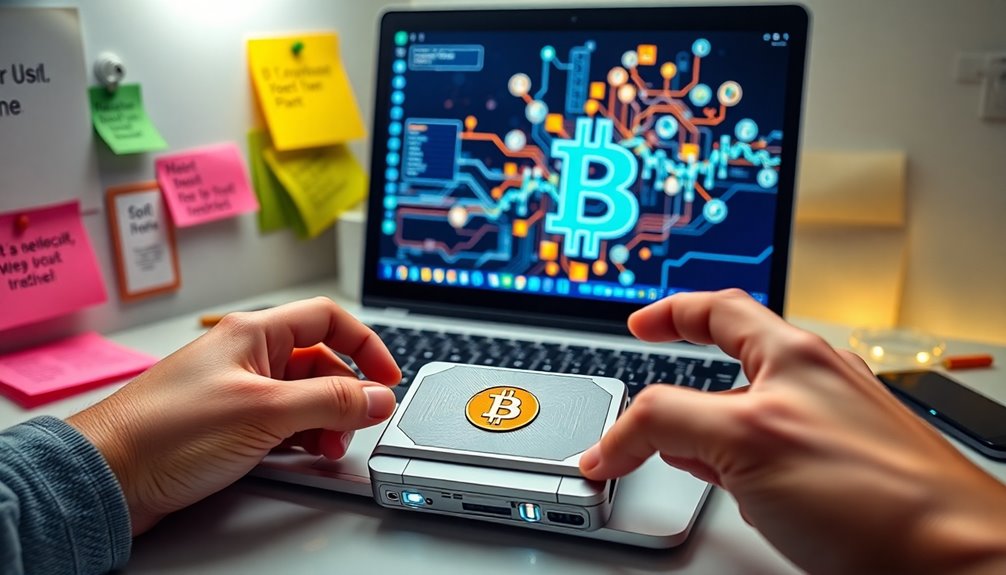When you find yourself facing a stuck Bitcoin transaction in 2025, it's crucial to understand the steps you can take to resolve the issue effectively. Start by checking the transaction status on a block explorer to see if it's confirmed or still pending. If it's stuck, you might want to look into using a transaction accelerator or consider adjusting the fee with RBF. However, the intricacies of network congestion can complicate matters further, leading you to wonder about the best strategies to ensure your transaction gets processed swiftly. What should you prioritize next?
Key Takeaways
- Check Transaction Status: Use a block explorer to verify if your transaction is still pending or confirmed on the blockchain.
- Verify Fees: Ensure your transaction fee meets the current network requirements; low fees can cause delays in confirmation.
- Use a Transaction Accelerator: Some services prioritize your transaction for a fee, helping it get confirmed faster in congested times.
- Consider Replacing Transaction: If your transaction is stuck, you can use the Replace-by-Fee (RBF) option to resend it with a higher fee.
- Wait for Confirmation: Sometimes, simply waiting is necessary; network congestion can resolve, allowing your transaction to be confirmed later.
Understanding Bitcoin Transaction Mechanics

When you initiate a Bitcoin transaction, you start by specifying the amount you want to send and the recipient's public address. Using your wallet, you input this information to create the transaction. Once you've set the amount and recipient, you sign the transaction with your private key. This signature proves ownership and ensures authenticity, similar to signing a check. After signing, the transaction gets broadcast to the Bitcoin network, where nodes collect it from the memory pool. Miners then gather these transactions to validate and add them to a block. This process involves checking digital signatures and ensuring you have sufficient balance. Once validated, your transaction becomes part of the immutable blockchain, ensuring it's secure and permanent. Transactions are broadcast but may remain pending confirmation, typically lasting under an hour with optimal fee rates.
Regulatory Changes Impacting Transactions

The landscape of Bitcoin transactions is increasingly shaped by evolving regulations that impact how you engage with cryptocurrencies.
A significant shift in U.S. oversight may see the SEC hand crypto regulation to the CFTC, which will clarify what defines a security versus a commodity, reducing litigation and streamlining compliance. This potential transfer of oversight to the CFTC is expected to foster innovation in the crypto space. Additionally, as investors seek to diversify their portfolios, many may consider Gold IRAs as a hedge against the volatility often seen in cryptocurrency markets.
Meanwhile, the IRS now mandates that you calculate the cost basis of your crypto on a wallet-by-wallet basis, enhancing transparency but increasing your record-keeping burden.
In the EU, the MiCA regulation introduces standardized rules, requiring companies to obtain licenses and ensuring consumer protection.
These changes create both challenges and opportunities, ultimately paving the way for a more robust and trustworthy crypto marketplace.
Cryptocurrency Price Volatility Analysis

Understanding cryptocurrency price volatility is crucial for navigating the unpredictable nature of the market. Market sentiment plays a significant role in price fluctuations, as emotions like fear and greed drive trading decisions. You'll notice that positive news can quickly boost prices, while negative reports often lead to sharp declines.
Trading volume and liquidity are also key factors; surges in volume can trigger rapid price changes, especially in futures markets. Additionally, macroeconomic indicators, such as inflation rates, directly influence market dynamics. Economic downturns may shift investor interest toward cryptocurrencies as safer assets.
Finally, technological advancements, like smart contracts and AI integration, can stabilize prices by enhancing transaction security and efficiency, making the market more attractive to investors. As institutional adoption increases, the influence of larger players in the market can further amplify these volatility patterns.
Corporate Blockchain Integration

As businesses seek to enhance efficiency and security, corporate blockchain integration has emerged as a game-changer.
With enhanced data security through digital signatures, your customer loyalty and revenue can significantly increase. The immutable records created by blockchain allow for easy tracking of changes, which is vital for managing ERP systems.
You'll also benefit from real-time data verification that cuts audit costs and speeds up reconciliation. By automating manual tasks with smart contracts, you can reduce operating costs and eliminate the need for intermediaries. Additionally, implementing a scalable blockchain solution allows businesses to adapt to growing data needs without sacrificing performance.
Most importantly, blockchain fosters improved transparency and traceability, providing all participants a shared view of information, reducing disputes, and building trust among stakeholders.
Embrace these advancements to stay competitive in the evolving business landscape.
Election Year Market Reactions

With the recent election results, markets reacted swiftly, showcasing a notable surge in Bitcoin and other cryptocurrencies. Bitcoin broke past previous all-time highs, driven by a wave of optimism following Trump's victory. Bitcoin increased by 77% year-to-date, reflecting the growing market enthusiasm. Altcoins like Ethereum and Dogecoin also rallied, reflecting broad market enthusiasm. This surge marked a new phase of price discovery, as retail investors flocked back to the market, evidenced by rising Google searches and YouTube views. Trump's pro-crypto stance played a significant role, with his pledges to enhance the crypto environment boosting investor confidence. Anticipation of favorable regulatory changes further fueled this positive sentiment. The increase in mining difficulty due to higher participation rates may also influence future transaction speeds and fees.
Emerging Technologies in Transactions

Emerging technologies are revolutionizing transactions, making them faster, more efficient, and accessible.
Blockchain advancements, like tokenization, enhance transparency by digitizing traditional assets. You'll find that cross-border transactions become quicker and cheaper, with over 100 countries exploring central bank digital currencies (CBDCs). The emergence of asset tokenization as a key trend in 2025 is linking traditional finance with blockchain, providing new opportunities for seamless transactions. Additionally, Bitcoin IRAs allow for tax-efficient growth in retirement savings, further enhancing investment strategies.
Smart contracts automate processes, eliminating intermediaries and ensuring compliance. Decentralized Finance (DeFi) platforms broaden access to financial services, while blockchain's secure digital verification reduces fraud risks.
Additionally, tools like Replace by Fee (RBF) and mempool management help you navigate transaction speeds and costs effectively. Understanding network congestion is crucial to avoid stuck transactions, so stay informed about prioritizing your transactions during peak times.
Embrace these innovations to streamline your transaction experience.
Frequently Asked Questions
How Can I Track My Stuck Bitcoin Transaction Status?
To track your stuck Bitcoin transaction status, start by locating your Transaction ID (TXID).
Use a blockchain explorer like Mempool.space or Block Explorer to input your TXID and check the transaction details. You'll see if it's pending or confirmed, along with the number of confirmations.
If it's stuck, consider resending it with a higher fee or using transaction accelerators to boost its priority in the mempool.
What Tools Can Help Expedite a Stuck Bitcoin Transaction?
Did you know that, on average, Bitcoin transactions can take up to 10 minutes to confirm?
If your transaction's stuck, you can use tools like Replace By Fee (RBF) to boost its priority by paying a higher fee.
Alternatively, Child Pays For Parent (CPFP) lets you create a new transaction that covers the original.
You might also consider Bitcoin accelerators or the Lightning Network for faster processing, especially during peak times.
Is There a Fee to Unstick a Bitcoin Transaction?
Yes, there's usually a fee to unstick a Bitcoin transaction.
When you increase the fee to make your transaction more attractive to miners, you're essentially paying for faster processing.
If you're using methods like Replace-by-Fee or Child Pays for Parent, you'll incur additional fees to prioritize your transaction.
To avoid getting stuck in the first place, always set a competitive fee based on current network conditions.
Can Sending a New Transaction Help My Stuck One?
Ever wondered if sending a new transaction can help unstick your Bitcoin? Yes, it can!
By creating a new transaction with a higher fee, you're making it more appealing to miners, increasing its chances of confirmation. This new transaction can effectively prioritize itself over the stuck one.
Just ensure you check the current fees and broadcast it promptly to the network. Keep an eye on the status, and you should see progress!
How Long Can a Bitcoin Transaction Remain Stuck?
A Bitcoin transaction can remain stuck for several hours to a few days, depending on various factors.
If it doesn't get confirmed within 72 hours, it's best to consider resending it with a higher fee.
Network congestion and low transaction fees play a significant role in how long your transaction stays in the mempool.
Conclusion
In the bustling world of Bitcoin, a stuck transaction can feel like a ship caught in a storm, drifting without direction. By following these steps, you can navigate the choppy waters and steer your transaction toward safe harbor. Whether you're using a transaction accelerator or adjusting fees, you're not just waiting; you're taking control. As the digital tide shifts, remember: with a little patience and the right tools, you'll watch your Bitcoin sail smoothly once again.









